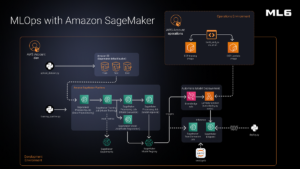“Protecting AI Algorithms on AWS: Safeguarding Data Privacy and Security with Best Practices”
Introduction:
Securing AI algorithms on AWS is crucial for ensuring data privacy and security. As artificial intelligence (AI) becomes increasingly integrated into various industries, protecting sensitive data and algorithms from unauthorized access and potential breaches is of utmost importance. This article will outline the best practices for securing AI algorithms on AWS, providing insights into how organizations can safeguard their data and maintain the integrity of their AI systems. By implementing these best practices, businesses can mitigate risks and build a robust security framework for their AI algorithms on the AWS platform.
Data Encryption Techniques for Securing AI Algorithms on AWS
Data Encryption Techniques for Securing AI Algorithms on AWS
In today’s digital age, data privacy and security have become paramount concerns for businesses and individuals alike. With the rise of artificial intelligence (AI) and the increasing reliance on cloud computing platforms like Amazon Web Services (AWS), it is crucial to implement robust security measures to protect sensitive data and AI algorithms. One of the most effective ways to achieve this is through data encryption.
Data encryption is the process of converting data into a form that is unreadable by unauthorized individuals. By encrypting data, businesses can ensure that even if it falls into the wrong hands, it remains protected and inaccessible. When it comes to securing AI algorithms on AWS, there are several encryption techniques that can be employed.
First and foremost, it is essential to encrypt data at rest. This means that data stored in databases or on disk drives should be encrypted to prevent unauthorized access. AWS provides a range of encryption options, including server-side encryption (SSE) and client-side encryption (CSE). SSE automatically encrypts data at rest using AWS-managed keys, while CSE allows users to manage their encryption keys. By encrypting data at rest, businesses can mitigate the risk of data breaches and unauthorized access.
Another crucial aspect of securing AI algorithms on AWS is encrypting data in transit. When data is being transferred between different systems or networks, it is vulnerable to interception and tampering. To protect data in transit, businesses should use secure communication protocols such as Transport Layer Security (TLS) or Secure Sockets Layer (SSL). These protocols encrypt data during transmission, ensuring that it remains confidential and intact.
Furthermore, AWS offers a service called AWS Key Management Service (KMS), which allows businesses to manage their encryption keys securely. KMS provides a centralized key management system, making it easier to control access to encrypted data. By using KMS, businesses can ensure that only authorized individuals have access to encryption keys, further enhancing data security.
In addition to encrypting data, businesses should also implement access controls to restrict who can access AI algorithms and sensitive data. AWS Identity and Access Management (IAM) enables businesses to manage user access and permissions effectively. By assigning appropriate roles and permissions, businesses can ensure that only authorized individuals can access and modify AI algorithms and data.
Moreover, it is crucial to regularly monitor and audit access to AI algorithms and data. AWS CloudTrail provides detailed logs of user activity, allowing businesses to track who accessed what and when. By monitoring access logs, businesses can quickly identify any suspicious activity and take appropriate action to mitigate potential security risks.
Lastly, businesses should consider implementing multi-factor authentication (MFA) for added security. MFA requires users to provide multiple forms of identification, such as a password and a unique code sent to their mobile device, before accessing AI algorithms or sensitive data. This additional layer of security significantly reduces the risk of unauthorized access, even if passwords are compromised.
In conclusion, securing AI algorithms on AWS requires robust data encryption techniques. By encrypting data at rest and in transit, managing encryption keys securely, implementing access controls, monitoring user activity, and using multi-factor authentication, businesses can significantly enhance data privacy and security. As AI continues to revolutionize industries, it is crucial to prioritize data protection to maintain trust and safeguard sensitive information.
Implementing Access Controls and Authentication Mechanisms for AI Algorithms on AWS
Implementing Access Controls and Authentication Mechanisms for AI Algorithms on AWS
When it comes to securing AI algorithms on AWS, implementing access controls and authentication mechanisms is crucial for ensuring data privacy and security. With the increasing use of AI in various industries, protecting sensitive information and preventing unauthorized access to AI algorithms has become a top priority.
Access controls play a vital role in determining who can access and modify AI algorithms and the data they process. By implementing access controls, organizations can limit access to only authorized individuals or systems, reducing the risk of data breaches or unauthorized modifications.
One of the best practices for implementing access controls is to follow the principle of least privilege. This means granting users or systems only the minimum level of access required to perform their tasks. By limiting access rights, organizations can minimize the potential damage caused by a compromised account or system.
AWS provides several tools and services that can help organizations implement access controls effectively. AWS Identity and Access Management (IAM) allows organizations to manage user access to AWS resources, including AI algorithms. By creating IAM roles and policies, organizations can define fine-grained permissions for different users or groups, ensuring that only authorized individuals can access AI algorithms.
In addition to access controls, authentication mechanisms are essential for verifying the identity of users or systems accessing AI algorithms. AWS offers various authentication mechanisms, such as multi-factor authentication (MFA) and AWS Single Sign-On (SSO), to enhance the security of AI algorithms.
MFA adds an extra layer of security by requiring users to provide additional authentication factors, such as a one-time password or a biometric scan, in addition to their username and password. By enabling MFA for accessing AI algorithms, organizations can significantly reduce the risk of unauthorized access, even if a user’s credentials are compromised.
AWS SSO simplifies the management of user access to multiple AWS accounts and applications. With SSO, organizations can centrally manage user identities and permissions, making it easier to enforce access controls and ensure that only authorized users can access AI algorithms.
Another important aspect of securing AI algorithms is monitoring and logging access activities. By monitoring access activities, organizations can detect and respond to any suspicious or unauthorized access attempts promptly. AWS CloudTrail provides detailed logs of API calls made to AI algorithms, allowing organizations to track who accessed the algorithms, when, and from where.
Furthermore, organizations can leverage AWS CloudWatch to set up alarms and notifications for specific access events, such as failed login attempts or unusual access patterns. By proactively monitoring access activities, organizations can quickly identify and mitigate potential security threats.
In conclusion, implementing access controls and authentication mechanisms is crucial for securing AI algorithms on AWS. By following the principle of least privilege, organizations can limit access to only authorized individuals or systems. AWS IAM, MFA, and SSO provide effective tools for managing user access and enhancing authentication security. Additionally, monitoring and logging access activities using AWS CloudTrail and CloudWatch enable organizations to detect and respond to potential security threats promptly. By implementing these best practices, organizations can ensure the privacy and security of their AI algorithms and the sensitive data they process.In conclusion, securing AI algorithms on AWS requires implementing best practices for data privacy and security. This involves ensuring proper access controls, encryption, and monitoring mechanisms are in place to protect sensitive data. Additionally, regular vulnerability assessments and audits should be conducted to identify and address any potential security risks. By following these best practices, organizations can enhance the security of their AI algorithms and safeguard the privacy of their data on AWS.











